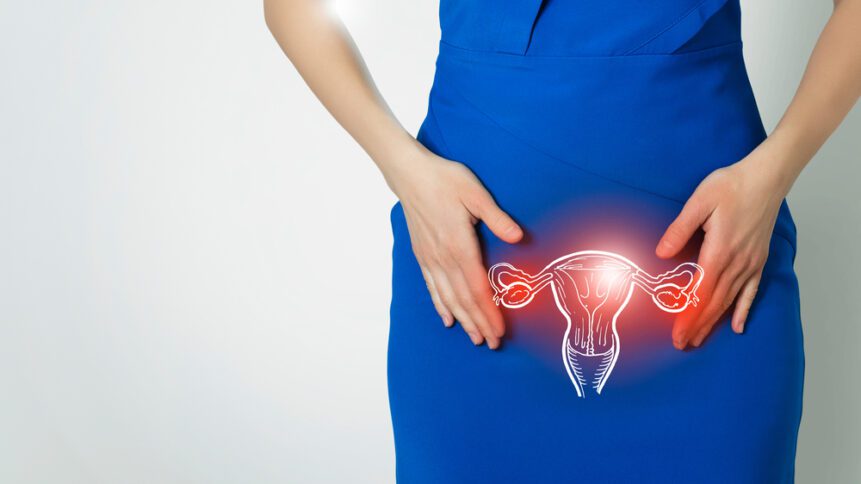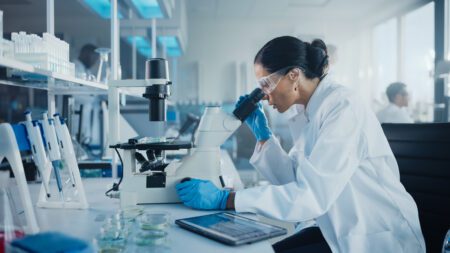
This article was made possible thanks to an unrestricted educational grant by Guerbet.
When a person is dealing with infertility, there are so many questions, but the first and most critical may be: What do I need to do to conceive?
A woman may go through a battery of blood tests. A male partner may have sperm analysis done. There are also diagnostic tests to see if the size, shape, and composition of the reproductive parts are conducive to conception.
One test that has been around for a century but inspiring new interest, is a hysterosalpingography (HSG), a diagnostic x-ray.
One test that has been around for a century but inspiring new interest, is a hysterosalpingography (HSG), a diagnostic x-ray. Infertility specialists sometimes recommend a water-based or oil-based HSG to determine the state of the fallopian tubes, when patients experience symptoms of endometriosis, or when more obvious causes of infertility are ruled out.
Dr. Serena Chen, the Director of Reproductive Medicine at Saint Barnabas Medical Center in New Jersey, says: “If a woman has had 12 months of unprotected intercourse with no conception and you’re under 35 years old, then we may do it for that patient.”
If the HSG shows that there’s a blockage, then that can be addressed.
One exciting outcome—some patients and doctors have seen that after an HSG, the chance of a woman getting pregnant goes up.
A 2020 review of 15 clinical trials (including 3,900 women) suggested that compared to no treatment, tubal flushing with a water-based or an oil-based contrast fluid may increase the chance of live birth and clinical pregnancy.
This therapeutic effect has been particularly noticeable for women with endometriosis (when endometrial tissue is found outside the uterus). Women with endometriosis often experience pain and infertility.
The link of endometriosis to infertility is not fully understood but Dr. William Burns, a reproductive endocrinologist at Marshall Health in West Virginia, says that the inflammation in the body caused by endometriosis or other disruptors, may interfere with an egg and sperm connecting or with an embryo developing.
Fertility specialists and researchers think that a positive outcome of the HSG may be by one or more mechanisms. That the tubal flushing from the HSG, particularly an oil-based HSG, can clear debris interfering with conception, or that it can positively alter the endometrial cavity. Some experts like Dr. Burns believe that the HSG may affect peritoneal inflammation. (The peritoneal cavity is where the end of the fallopian tube brushes against the ovary, which is where the sperm meets the egg. If fertilization occurs, then the fertilized egg then moves down the tube to the uterus.)
The poppy seed oil-based HSG, Lipiodol by Guerbet, has long been used for a variety of radiological diagnostics studies. Its proposed therapeutic fertility effect has been suggested and demonstrated for years, but not widely pursued until recently.
Dr. Burns supports the use based on his own practice. Over the last 19 years, he says he has seen hundreds of his infertility patients, particularly those with endometriosis, get pregnant after having the oil-based HSG procedure. He believes that it is “under-appreciated.”
Kerri Morton couldn’t agree more.
Morton gave birth to two girls, brought into this world, she says, thanks to the oil-based HSG test.
The Proof Is In the Pregnancy (Kerri Morton’s Story)
Morton gave birth to two girls, brought into this world, she says, thanks to the oil-based HSG test. (She and her husband also have an adopted son.)
Morton says: “I believe 100% that for me, having endometriosis, it was this treatment that worked, because I had my first pregnancy after 14 years, right after the treatment, and then it worked a second time, although it took longer.”
Morton, a nurse in Bellingham, Washington, was married at age 20 and she and her husband started trying to have a baby right away.
She says: “I always wanted to be a mother, and I come from a big family. All my brothers and sisters had kids, so I didn’t see infertility coming. After years of trying and testing, with no answers, I had surgery to determine if I had endometriosis. It confirmed that I did. I never had any symptoms besides the infertility. They were able to laser off all the endometrial implants, and gave me a 60% chance that I would get pregnant.
“Months went by and I still didn’t get pregnant. Due to our religious beliefs, IVF was not on the table, so I felt utter despair.”
After continued heartbreaking setbacks, they were thrilled to adopt their son, Alex.
Morton and her husband wanted to grow their family but having experienced traumatic near-miss adoptions, she refocused on trying to improve her pregnancy odds.
She found out about the work of New Zealand infertility specialist Dr. Neil Johnson with endometriosis patients. After extensive research and patient care in the field, a study he headed showed that the “endometrial bathing,” of the oil-based HSG, had a “dramatic, short term fertility-enhancing effect for women with endometriosis.”
In 2018, she went to New Zealand to have the procedure. She figured she might as well try, while also enjoying a bit of vacation.
Morton says, “I didn’t really believe it was going to work, because I thought my body was hopeless by then.”
She got pregnant in her next cycle, and her daughter Amaryllis, was born in May 2019.
She and her husband then wanted another child. After another 1 1/2 years with no success,
Morton decided to try the oil-based HSG again. But…the Covid pandemic hit, and safety protocols prevented travel to New Zealand.
She found Dr. Burns in the U.S. and had the oil-based HSG procedure again. It took six months but she got pregnant again and had her second daughter, Philomena, in December 2021.
She says that In New Zealand she paid $750 out of pocket for the test (plus the plane fare and other travel expenses). For the second procedure, in the U.S., after insurance coverage, she paid $900.
Click here to watch Kerri Morton’s story.
What Is an HSG Procedure Like?
Dr. Burns agrees with Dr. Chen that the HSG is done in conjunction with a thorough infertility evaluation.
If there are obvious sperm or ovulation issues with a couple, that’s dealt with first.
If an HSG is needed, Dr. Chen says that it has to be done at a hospital or radiology facility, so the contrast dye is the one the facility uses, which is often a water-based contrast fluid.
Dr. Burns specifies an oil-based HSG, especially if endometriosis is diagnosed or presumed by symptoms. The HSG test is then scheduled for the early part of a woman’s cycle.
Some doctors strongly recommend that women take pre-procedure medicine for pain, anxiety, and possible infection, because there is some discomfort involved, and potential risks with any kind of medical procedure.
Some patients like Morton decide against taking meds.
Morton says that she didn’t take medicine for the New Zealand procedure so she opted out of it for the U.S. test. For her the HSG was uncomfortable, but not unbearable.
The procedure, from the time a woman lays down, takes 15 to 20 minutes.
Pain may occur when a small balloon attached to the catheter is inserted into the cervix and inflated, or when the dye is released. Both of these steps distend the uterus, and the pressure can be uncomfortable.
Then diagnostic images are taken.
After the procedure, the woman may feel “crampy,” like during a really bad period.
Morton said that her experience was relatively mild. “Honestly, when you get any poking and prodding ‘up there,’ it’s kind of similar. You’re kind of bracing for it, knowing it might not be pleasant. But other than a bit of discomfort and pressure, it was OK. Of course, maybe for some women it would be more difficult.”
The cramping should taper off within 30 minutes.
Doctors first look at the images to see if the fallopian tubes show any physical abnormalities—in shape or blockage.
Dr. Burns says that if a fallopian tube is blocked, the x-ray would show contrast fluid stuck in the fallopian tube.
Dr. Burns says that if a fallopian tube is blocked, the x-ray would show contrast fluid stuck in the fallopian tube.
If the fallopian tubes are not damaged, the oil from the HSG would pool in the peritoneal cavity, coating it.
Dr. Burns believes that the bathing or flushing effect of the fluid, particularly the oil, helps suppress or treat the inflammation caused by endometriosis.
Adverse Effects?
Though more research is needed, adverse effects seem to affect a low percentage of women who have the oil-based HSG.
The most concerning adverse effect during the tubal flushing is intravasation (flow of contrast fluid into the blood or lymphatic vessels), which could lead to embolism. Actual incidence is extremely rare. It is enough of a concern, Dr. Chen says, that some doctors avoid the oil-based HSG.
The treatment, on rare occasions, could lead to thyroid dysfunction, due to the high percentage of iodine in the contrast fluid. Blood monitoring may be requested and if needed, medication to balance the thyroid function.
Side effects, especially as related to each patient’s unique medical profile, are important if considering the tubal flushing HSG.
Be Your Own Advocate
The struggle when trying to conceive is real. Finding the problem and the right treatment may require a lot of trial and error testing and research.
Ask questions and look for ways to rule out obstacles and increase your odds.
Diagnostics like an HSG can not only help doctors look for obvious fertility interference, there could be a potential pregnancy bonus. Find out for yourself.
To learn more, speak with your healthcare provider.


Listen to stories, share your own, and get feedback from the community.


















